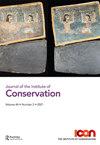Er:YAG laser cleaning of ‘San Marziale in Gloria’ by Jacopo Tintoretto in the Church of San Marziale, Venice
IF 1
0 HUMANITIES, MULTIDISCIPLINARY
引用次数: 8
Abstract
Abstract This article presents a parameter optimisation study for the use of an Er:YAG laser in combination with different solvent mixes for the cleaning of a large oil painting on canvas by Jacopo Tintoretto. The painting underwent restoration work between the 1700s and the mid-1900s in which it was lined and some areas were coated with a pigmented protective varnish, which has oxidised over time and has completely obscured the work. Analysis was undertaken in order to study the condition of the work, the painting technique used, and to monitor and verify the effectiveness of the cleaning treatments considered to remove the oxidised varnish. The article reports how the careful calibration and use of cleaning techniques involving the Er:YAG laser and solvent mixes have led to a full recovery of the vibrant chromatic intensity to the pictorial surface of the work.威尼斯圣马尔齐亚莱教堂Jacobo Tintoretto的Er:YAG激光清洁“格洛里亚的圣马尔齐亚莱”
摘要:本文介绍了使用Er:YAG激光与不同溶剂混合清洗雅各布·丁托列托(Jacopo Tintoretto)帆布上的大型油画的参数优化研究。这幅画在18世纪到20世纪中期经历了修复工作,在修复过程中,它被内衬起来,一些区域被涂上了一层着色的保护漆,随着时间的推移,这种漆已经氧化,完全掩盖了这幅画。进行分析是为了研究工作的状况,所使用的绘画技术,并监测和验证清洗处理的有效性,以去除氧化清漆。文章报道了如何仔细校准和使用涉及Er:YAG激光和溶剂混合物的清洁技术,导致了工作的图像表面的充满活力的色彩强度的完全恢复。
本文章由计算机程序翻译,如有差异,请以英文原文为准。
求助全文
约1分钟内获得全文
求助全文
来源期刊

Journal of the Institute of Conservation
HUMANITIES, MULTIDISCIPLINARY-
CiteScore
1.50
自引率
0.00%
发文量
22
期刊介绍:
The Journal of the Institute of Conservation is the peer reviewed publication of the Institute of Conservation (Icon). As such, its aims reflect those of Icon, to advance knowledge and education in conservation and achieve the long term preservation and conservation of moveable and immoveable cultural heritage. The Journal provides a collective identity for conservators; it promotes and supports both the profession and professionalism. With international contributions on all aspects of conservation, it is an invaluable resource for the heritage sector. The specific aims of the Journal are to: 1. promote research, knowledge and understanding of cultural heritage conservation through its history, practice and theory 2. provide an international forum to enable and disseminate advances in research, knowledge and understanding relating to conservation and heritage 3. champion and support professional standards of heritage conservation in the UK and internationally 4. provide a permanent record of issues relating to conservation and heritage 5. be financially and operationally sustainable. To achieve these aims, the Journal invites contributions from all those involved in the conservation of cultural heritage and related activities. Areas of interest include understanding cultural heritage materials and their degradation; subject reviews and histories of cultural heritage materials and conservation treatments; new, innovative or improved approaches to conservation and collections care theory, practice, communication, management and training; case studies demonstrating new, innovative or improved approaches; and conservation in its wider context. Submitters are encouraged to demonstrate how their work is of practical application to conservation. To maintain professional standards and promote academic rigour, submissions of articles and shorter notices are subject to an anonymous peer review process.
 求助内容:
求助内容: 应助结果提醒方式:
应助结果提醒方式:


